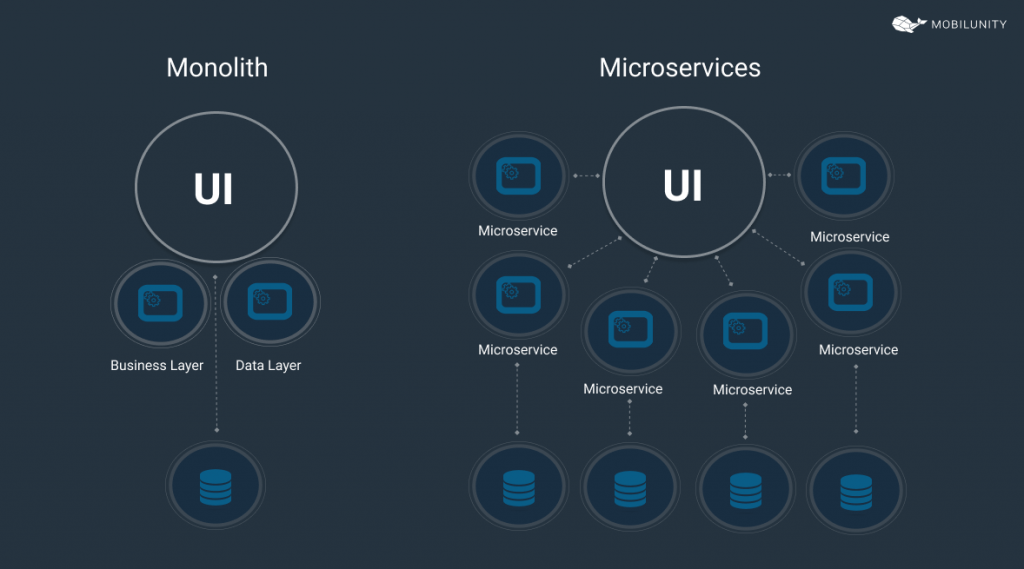Role of Microservices Integration in Continuous Delivery

- Microservices in a Nutshell
- Comparing Monolith vs Microservices Enterprise Integration
- Advantages and Pitfalls of Microservices Integration
- Understanding Continuous Delivery Microservices with DevOps
- How DevOps Microservices Can Overcome Microservices Challenges
- Why Companies Trust Mobilunity with Microservices Integration Testing and Implementation
- Mobilunity as a Trusted Microservices DevOps Solutions Provider
Since the market expectations are constantly growing, and customers demand rapid reaction to their needs and concerns, companies utilize continuous integration and delivery to deliver results fast and efficiently. Why do companies use microservices with DevOps/cloud solutions, and what are the advantages and possible pitfalls of microservices integration? We discuss these and more below.
Microservices in a Nutshell
Initially, applications were developed and deployed with a monolithic architecture only, meaning they were built as a single, indivisible unit. All functions were managed in one place; there was one large codebase and no modularity. So, when developers needed to change or update something, they had to access the whole stack and work on the app level. The role of microservices integration in continuous delivery is crucial for modern software development, and businesses can leverage the expertise of a creative employment agency and a remote staffing agency to assemble specialized teams capable of effectively implementing and managing microservices architectures.
This architecture allows for fast development, testing, and deployment and is still used for software development. However, when it comes to scaling and further customization, programmers have to go through hundreds of steps to implement the needed functionality. Once there’s a bug, the whole application stots and developers may be overloaded with constantly fixing bugs instead of working on further development and optimization.
In short, the bigger and more complex the monolith app becomes, the less effective it is, and the harder it is to manage, change, or debug the solution, as mentioned in the Dev Community. The sole build pipeline creates a bottleneck for releasing too big and too complex products, and here’s where microservices come into play.
A microservices architecture implies a monolith broken into smaller components with separate functions, codebase, and even teams working on them. This allows for continuous deployment, automated microservice integration testing, easier scalability, decreased risks of major app failures, faster time to market, and speedy reaction to customer demand, among other benefits.
No wonder that as per the O’Really report, 77% of companies have already using integration and monitoring microservices DevOps, with 15% of them joined this year, which proves the stable growth of the microservices adaptation. According to the Market Analysis, the DevOps and microservices global market will reach $10 billion by 2023.
Comparing Monolith vs Microservices Enterprise Integration
For your convenience, we gathered the main points of the monolith and microservices-based architectures in the table below:
| Monolith | Microservices |
| A traditional approach to building applications | A newer approach that considers every app process as a separate service with its own logic, database, and performed functions |
| Built as a single, indivisible unit with one large codebase | A collection of smaller independent units (microservices) |
| Easy debugging and end-to-end testing until the app becomes complex | Requires a well-thought-out testing approach for working with a multitude of independently deployable components |
| Simple to develop from scratch | Essential to handle all connections between multiple modules and databases when developing a microservices architecture |
| Simple deployment, since there’s just one file or directory, and you don’t need to handle many deployments | Great deployment flexibility of independent components, which can be released and updated independently, and a bug in one microservice influences only on the specific service and not the whole app |
| Fewer cross-cutting concerns since there’s only one application to handle | Cross-cutting concerns should be taken into consideration, including externalized configuration, logging, metrics, and so |
| Hard to understand and manage once the monolithic application becomes complex | Easy to understand the architecture at any scale since it’s built with small and simple components |
| Hard to scale and implement changes to a large, complex app. Also, you can’t scale components independently, only the whole app | Easy and fast to scale, as each component can be changed scaled independently. Also, easy to add new features |
| Since any code change affects the whole application, all changes need to be coordinated thoroughly and well-weighted prior to implementation on the app level | A high level of agility and more freedom for changes and experiments that can be implemented with lower risks and errors, thanks to the microservice-based structure |
| Problematic to use any new technology since it requires the whole monolithic application to be rewritten | Great flexibility in choosing technologies, either from the start or during the development process. The technologies and frameworks can be applied for each or specific microservices |
As you can see, a monolithic architecture usually consists of business logic, user interface, data access layer, and a single database. Such solutions are unified, with all functions managed in one place and one large codebase. Thus, with no modularity, it requires developers to apply changes to the whole app at once if they need to change or update something.
As for the microservices architecture, the functionality and user interface broke down into independent modules with their own codebases and features. Each microservice component has its own scope and can be deployed, changed, scaled, and updated fast and independently.
Advantages and Pitfalls of Microservices Integration
Let’s sum up the benefits of the microservices architecture:
- Independent components can be deployed and updated independently, which allows for great flexibility;
- A bug in one microservice affects only the given function and not the whole app;
- It is easier and faster to add new features compared to the monolith architecture;
- It is easy to understand the architecture split up into small and simple components;
- Each component can be scaled independently;
- Notable cost-effectiveness or developing and updating applications;
- You can use any technology or framework needed, even for one microservice;
- Great agility;
- Lower risks and fewer errors when implementing changes or experiments;
- Easier fault isolation and quicker fixes;
- Faster time to market;
- Faster response to customers’ needs.
Let’s now look at the potential pitfalls of microservices. It is important to note that with the right tools and expertise at hand, it is possible to mitigate the risks and only reap the benefits of this solution:
- Number of pipelines (if you don’t have automated CI/CD and Continuous Deployment yet, and you don’t have a DevOps expert, the development team may be overwhelmed at first);
- Complexity of the microservices architecture (since it is a distributed system, it is important to set up connections between services and databases correctly);
- Complex system distribution;
- Cross-cutting concerns;
- Advanced testing (caused by the multitude of independently deployable components can be set up and managed by an experienced DevOps specialist).
Understanding Continuous Delivery Microservices with DevOps
It is essential to note that the modern cloud-native application architectures won’t be complete with microservices. Companies utilize modern practices like DevOps and modern approaches like microservices to design and deploy applications as independent services with great agility and operational efficiency.
DevOps practices promote the idea of breaking large problems into smaller pieces and resolving them one by one within a team. That’s why microservices fit perfectly into the DevOps approach since they empower small independent teams to work on the specific functionality and collaborate to ensure the quality of the end product. Microservices and continuous integration delivery allow for easy scaling up or down without impacting the whole system and without time-consuming development and testing steps.
With containerized microservices, new services can become immediately operational on any system or device, also contributing to the automation or operations, reduced risks of any conflicts between libraries or frameworks. Since Docker containers are portable and isolated, it makes them a preferable option for building a microservices architecture with containers. To orchestrate the containers, DevOps developers utilize cluster managers like Kubernetes or Docker Swarm.
Combining DevOps approaches with microservices implementation in the development, testing, and deployment can increase the productivity of the team and the quality of the product.
How DevOps Microservices Can Overcome Microservices Challenges
Although there are potential challenges associated with microservices implementation, with the right design microservices DevOps/cloud, the company can gain all the benefits of this architecture type and overcome the possible challenges with the help of a DevOps expert. Here are the challenges that may arise:
- Rapid reaction to bugs, market requirements, customers’ demand, and feedback (by automating DevOps pipeline, you can ensure efficient development and comprehensive testing in line with the quality standards and within the shortest time possible);
- More complex test automation (DevOps can implement continuous testing to ensure software quality, which includes security testing, measured value, risk mitigation, and alignment with user requirements);
- Careful management of microservice versions and the consistency of the ecosystem (DevOps can take control of versions and operating environment monitoring with the help of the right tools);
- Ensuring and supporting local microservices development system (DevOps can make sure there are either many isolated development environments or set up realistic development environments for programmers);
- Automating the infrastructure for microservices (DevOps infrastructure automation approaches can facilitate autoscaling, automatic deployment, and dynamic service registration at runtime);
- Alignment of Development and Operations (when working with microservices, Dev and Ops need to collaborate even more, preferably in the same cross-functional team);
- Ensuring the delivery speed (the main benefit of the microservices architectures is speed, and DevOps helps to achieve it through the right technology, established processes, and resources);
- Monitoring microservices effectively (DevOps best practices bring a lot of innovations and open source tools for effective monitoring, including a dynamic approach that involves log aggregation, capturing metrics across distributed environments, etc.)
Why Companies Trust Mobilunity with Microservices Integration Testing and Implementation
Given the possible complexity of microservices solutions, many businesses seek expert assistance from external providers like Mobilunity experienced with DevOps microservices Docker services. Here’s how Mobilunity can help your company with microservices continuous integration Docker:
- Increased levels of DevOps productivity
- More frequent and fast software releases
- Better quality of code and its reusability
- Implementation and improvement of automated services
- Improved product quality
- Scalability
- Flexibility
- Resilience
- Improved testing processes
- Optimized development costs
- Driven innovation
Find out more:
- Where to find and hire remote ci/cd developers?
Mobilunity as a Trusted Microservices DevOps Solutions Provider
If you are looking for a reliable services provider to assist you with building microservices or developing specific functionality, i.e., Kafka integration with Python microservices, you’ve come to the right place.
Mobilunity is a reputable Ukrainian outstaffing company that has been operating on the global IT market for more than 10 years. We help SMBs, and large-scale corporations find the right IT resources to match their business needs and project requirements, and we are happy to see our clients fully satisfied with our solutions and noting our utmost professionalism and dedicated approach.
Our Recruitment team has our own time-tested approach based on the best industry practices and our experience to source and hire the best matching candidates for the business. Get in touch with our Mobilunity experts, and let us help you find the right DevOps Docker microservices expert to benefit your company.
Looking for high-end DevOps microservices integration services? Contact Mobilunity!
Disclaimer: All salaries and prices mentioned within the article are approximate numbers based on the research done by our in-house Marketing Research Team. Please use these numbers as a reference for comparison only. Feel free to use the contact form to inquire on the specific cost of the talent according to your vacancy requirements and chosen model of engagement.

















